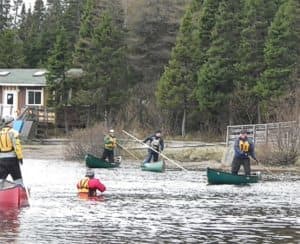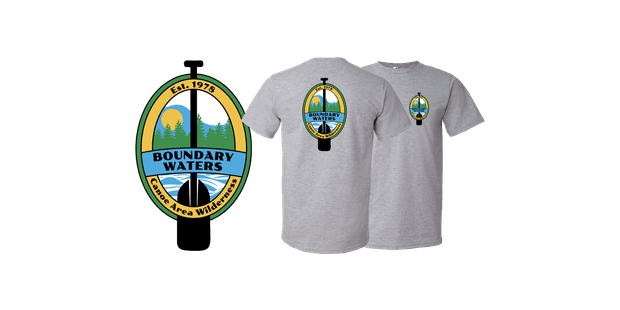How to Pole a Canoe
I love that there's various canoe cultures. If you paddle places like Quetico or the Boundary Waters you'll see lots of asymmetrical stream-lined canoes propelled by bent-shaft paddles. The choice matches the landscape. Lots of big lakes and minimal portages. In central Canada you have the prospector canoe and beaver tail paddle. It also matches the varied landscape of lakes, ponds, river and creeks. What's also essential in places such as the province of New Brunswick in Canada and the Sate of Maine in the U.S., is the art of propelling your canoe by pole. The paddle becomes secondary due to shallow rivers with gentle gradients and boulder-strewn river bottoms. Poling is highly effective in such an environment.
Poling a canoe isn't as common as it once was, and learning the skill isn't easy. However, the technique can still be applied in canoe country where there's shallow rapids or just strong current. The problem is that the skill takes lots of practice. It's also difficult to find someone to teach you. Only a handful of traditional polers are left. I took a course through Paddle Canada during one of their symposiums. The instructors were Tim Humes and Kevin Siliker from New Brunswick. I'd highly recommend them. There's also a solid following on Facebook and I'm guessing someone there would be more than happy to take you out poling for the day.
It's all about balance, which is why it's good to get started in flat water on a warm day. Be warned, you might take the odd swim. Choose an area only a few feet deep and use a canoe you're comfortable standing up in. I prefer a prospector design; and the longer the canoe the better. It's easier to keep a 17 foot straight than a 14 foot.
~Get the BWCAW Tee~
With over 1,090,000 acres of wilderness area, the BWCAW is a paddler's paradise.
 The traditional pole is wood and approximately 11 to 12 feet long and 1-2 inches diameter. Some choose to carve there own from spruce, ash or tamarack. Other polers simply buy an aluminum one. A metal shoe is suppose to be added to one end of the pole to help grab the bottom of the river. I find these hard to find though and always end up just adding a short piece of copper or aluminum pipe.
The traditional pole is wood and approximately 11 to 12 feet long and 1-2 inches diameter. Some choose to carve there own from spruce, ash or tamarack. Other polers simply buy an aluminum one. A metal shoe is suppose to be added to one end of the pole to help grab the bottom of the river. I find these hard to find though and always end up just adding a short piece of copper or aluminum pipe.
Start with an empty boat and stand just aft of centre. Your legs should be arm's length apart, one fore and the another aft. Some polers choose to stand square but it's best not to start out that way. Having your legs slightly lateral provides a shock absorber when you suddenly strike a submerged rock; and you will hot a submerged rock. It also provides the ability to easily lean to canoe from side to side or give the canoe an extra push with your hips and torso. Just remember to keep your body loose and agile but remain centered.
To start, use the pole like a paddle. You can either double blade it like a kayak paddle to give you forward motion, or to one side like a single blade. I find the single blade technique keeps me from falling out of the canoe less. A J-stroke will be almost as effective as with a paddle to keep the canoe going straight due to the extra leverage you have with the pole. Same goes for a forward or reverse sweep.
Now it's time to graduate to pushing with the pole. Set the pole on the lake or river bottom, with it planted just a few feet back from where your stance in the canoe. Keep the pole close to the side of the canoe. Place your hands near the top of the pole, with the offside hand gripping higher up. Now, squat down as if you're sitting in a chair and push the pole straight back, using your body weight rather then your muscles to propel you forward. The push ends when the pole reaches your waist. You then repeat the pushing process by feeding the pole back to the initial position. Make sure to keep the pole parallel with the centre line of the canoe. By keeping the pole close to the canoe you shouldn't have to compensate too much to keep the boat going straight. If that's not working out for you though, use the pole like a rudder at the end of each push. In time, you will also figure out how to maneuver the canoe by shifting your weight from side to side, steering the bow in the desired direction.
It's common to switch from side to side - but it's also possible to stay on the one side of the canoe as well. You can also move the canoe sideways by pushing the pole off from the side, at a 90 degree angle.
The final level is to try your technique out in moving water. Again, make sure it's a nice warm day for a swim. The method stays the same but it's crucial to keep your bow light and stern heavier when pushing up current. You want to bow to float and not dig into the water. Make good use of eddies and try to stay inside the bend in the river. It's just like paddling whitewater in a way; you use the current to ferry from side to side. In theory, as long as you keep your bow straight into the current you'll remain dry and propel forward.
It all sounds simple enough - but it's not. However, I've witnessed expert polers move up current as graceful as a figure skater twirls on ice. It's an amazing skill that's worth a little bit of hard work - and a few accidental swims in the river.

Kevin Callan is the author of 11 books including "Wilderness Pleasures" and "The Happy Camper." A regular keynote speaker at major North American canoeing and camping expos for over 20 years, he has received three National Magazine Awards and four film awards, including top award at the prestigious Waterwalker Film Festival. Callan lives in Peterborough, Ontario, birthplace of the modern-day canoe.
Related Articles
Picture yourself approaching a set of rapids, with only a faint out-of-the-way animal trail heading up a…

